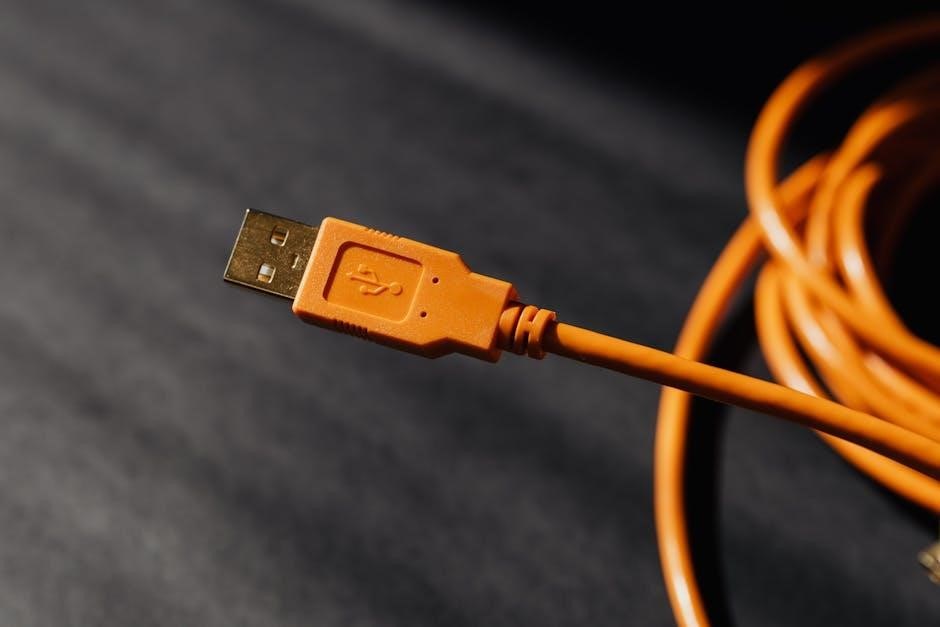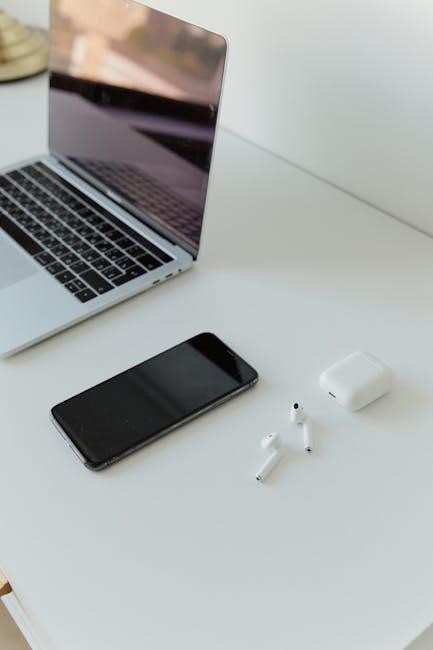The JBL Charge 3 is a portable Bluetooth speaker known for its robust sound and waterproof design. Featuring dual drivers and a passive radiator, it delivers powerful audio performance. Its built-in power bank allows users to charge devices; This makes it perfect for outdoor adventures. The IPX7 waterproof rating ensures durability.
Overview of JBL Charge 3
The JBL Charge 3 is a portable Bluetooth speaker designed for both indoor and outdoor use, offering a blend of powerful audio performance and rugged durability. Encased in a tube-shaped cradle, this speaker features two 50mm drivers that deliver high-quality stereo sound with a rated power of 20W. Its passive bass radiators enhance the low-frequency response, providing a deep and rich audio experience.
One of the standout features of the JBL Charge 3 is its IPX7 waterproof rating, which means it can be submerged in up to 1 meter of water for 30 minutes without damage, making it an excellent choice for pool parties, beach trips, or any outdoor activity where water exposure is a concern. However, it’s crucial to ensure that all cable connections are removed and the cap is tightly closed before exposing the speaker to water to prevent permanent damage.
In addition to its robust audio capabilities and waterproof design, the JBL Charge 3 also functions as a power bank, thanks to its built-in 6000mAh battery. This allows users to charge their smartphones, tablets, or other USB-powered devices on the go, making it a versatile companion for travel and outdoor adventures. The battery provides up to 15 hours of playtime, ensuring extended listening sessions without the need for frequent recharging.
Initial Setup and Powering On
Before enjoying the JBL Charge 3, a few initial steps ensure optimal performance and longevity. Upon unboxing, inspect the device for any physical damage. Charge the speaker fully using the provided USB cable and a compatible power source. This initial charge ensures the battery reaches its maximum capacity, which is crucial for extended playtime.
To power on the JBL Charge 3, locate the power button, typically found on the top or front of the speaker. Press and hold the power button for a few seconds until you see the LED indicator light up. The light will usually be white or blue, indicating that the speaker is now powered on and ready for use. If the speaker doesn’t power on, double-check that it has been charged adequately.
Once powered on, the JBL Charge 3 may automatically enter Bluetooth pairing mode, indicated by a flashing Bluetooth icon. If it doesn’t, press the Bluetooth button to initiate pairing mode. This makes the speaker discoverable to other Bluetooth-enabled devices like smartphones, tablets, and laptops. Ensure your device’s Bluetooth is enabled and search for available devices. Select “JBL Charge 3” from the list to establish a connection.
A successful connection is usually confirmed by an audible tone and a solid Bluetooth indicator light, signifying that the speaker is ready to play audio.
Bluetooth Pairing Instructions
Pairing your JBL Charge 3 with a Bluetooth device is a straightforward process, enabling you to enjoy wireless audio streaming. First, ensure the JBL Charge 3 is powered on. If it’s the first time powering on, it may automatically enter pairing mode, indicated by a flashing Bluetooth light.
If the speaker doesn’t automatically enter pairing mode, press the Bluetooth button, usually located on the top panel, to initiate pairing. The Bluetooth indicator will start flashing, signaling that the speaker is discoverable.
On your smartphone, tablet, or other Bluetooth-enabled device, navigate to the Bluetooth settings menu. Ensure Bluetooth is enabled, and your device will begin searching for available devices. In the list of discovered devices, find “JBL Charge 3” and select it.
If prompted, enter the pairing code, which is typically “0000” (although the Charge 3 usually pairs automatically without requiring a code). Once successfully paired, the Bluetooth indicator light on the JBL Charge 3 will stop flashing and remain solid, indicating a stable connection.
To disconnect, either turn off Bluetooth on your device or manually disconnect through the Bluetooth settings. The JBL Charge 3 can remember multiple paired devices, but it can only maintain an active connection with one device at a time.
For subsequent connections, simply ensure Bluetooth is enabled on your device, and the JBL Charge 3 will automatically connect if it’s within range.
Playback Controls (Volume, Play/Pause, Track Skipping)
The JBL Charge 3 offers intuitive playback controls directly on the speaker, allowing for convenient management of your music. The primary controls are located on the top of the speaker and are easily identifiable.
To adjust the volume, use the “+” and “-” buttons. Press the “+” button to increase the volume and the “-” button to decrease it. The speaker will provide audible feedback when the maximum or minimum volume is reached.
The play/pause function is controlled by a single button, often indicated by a play/pause symbol. Press this button once to pause the current track. Press it again to resume playback.
Track skipping is also managed through the speaker’s controls. To skip to the next track, quickly press the play/pause button twice. To return to the previous track, press the play/pause button three times in quick succession. This allows you to easily navigate your playlist without needing to use your connected device.
These simple controls provide a seamless user experience, ensuring you can enjoy your music without constantly reaching for your phone or tablet. The tactile buttons are designed for easy use, even in wet conditions, complementing the speaker’s waterproof capabilities.

Using JBL Connect Feature
The JBL Connect feature allows you to wirelessly link multiple JBL Connect-compatible speakers together to amplify your listening experience. This feature enhances the sound output and creates a more immersive audio environment, perfect for parties or larger gatherings.
To use JBL Connect, first ensure that all the JBL speakers you want to connect are compatible with the JBL Connect feature. Power on all the speakers you intend to link.
On the primary speaker, locate the JBL Connect button, which is usually marked with a symbol resembling multiple interconnected speakers. Press this button to initiate the pairing process. The speaker will begin searching for other JBL Connect-compatible speakers in range.
On the other speakers, press the JBL Connect button as well. The speakers will automatically detect each other and begin pairing. Once the connection is established, all the connected speakers will play the same music simultaneously from the same device.
You can connect multiple speakers to create a stereo setup or simply to increase the overall volume and coverage. To disconnect the speakers, simply press the JBL Connect button on any of the connected speakers. This will break the connection, and the speakers will revert to playing individually.
Waterproof Capabilities and Precautions
The JBL Charge 3 boasts an IPX7 waterproof rating, making it suitable for use in environments where it might be exposed to water. This rating signifies that the speaker can withstand immersion in water up to 1 meter deep for up to 30 minutes.

However, it is crucial to take certain precautions to ensure the waterproof capabilities are maintained and to prevent any potential damage to the speaker. Before exposing the JBL Charge 3 to water, always ensure that all cable connections are disconnected.
Additionally, make sure that the cap that covers the charging port and other connections is tightly closed. This cap is designed to create a watertight seal, preventing water from entering the internal components of the speaker. Failing to properly close the cap can compromise the waterproof integrity and lead to damage.

It is also important to note that the JBL Charge 3 should not be exposed to water while it is charging. Charging the speaker while it is wet can result in permanent damage to both the speaker and the power source. Always ensure the speaker is completely dry before plugging it in to charge.
Charging the JBL Charge 3
To ensure your JBL Charge 3 is always ready to deliver your favorite tunes, proper charging is essential. The speaker is equipped with a rechargeable battery that provides hours of playtime on a single charge. When the battery is low, you’ll need to connect the speaker to a power source using a Micro-USB cable.
First, locate the Micro-USB port on the back of the JBL Charge 3, typically found under a protective flap. Connect the Micro-USB cable to this port and plug the other end into a USB power adapter or a computer’s USB port. A full charge typically takes around 4.5 hours, so patience is key.
While charging, the LED indicator on the speaker will light up to indicate the charging progress. Once the battery is fully charged, the LED indicator will turn off or display a solid light, depending on the model. It’s best to use a 5V/2A power adapter for optimal charging speed, but using a computer’s USB port will also work, albeit at a slower rate.
Avoid using the speaker while charging to prolong the battery’s lifespan. Once fully charged, disconnect the speaker from the power source to prevent overcharging, which can damage the battery over time. Regularly charging your JBL Charge 3 will ensure it remains ready for your next listening session.
Using the Speakerphone Function
The JBL Charge 3 isn’t just a portable speaker; it also features a built-in speakerphone, allowing you to take calls hands-free. This is particularly useful when you’re occupied with other tasks or when you want to share a call with others. Using the speakerphone function is straightforward and adds another layer of convenience to this versatile device.
When a call comes in while your smartphone is connected to the JBL Charge 3 via Bluetooth, the music will automatically pause, and you’ll hear a ringtone through the speaker. To answer the call, simply press the “Play/Pause” button on the speaker. The built-in microphone will pick up your voice, allowing you to have a conversation without holding your phone.
To end the call, press the “Play/Pause” button again. The speaker will disconnect the call and resume playing music. If you want to reject an incoming call, press and hold the “Play/Pause” button for a few seconds. The call will be sent to voicemail, and you can continue enjoying your music.
The JBL Charge 3’s speakerphone also features noise and echo-canceling technology, ensuring clear audio quality for both you and the person on the other end of the line. This makes it ideal for conference calls or simply chatting with friends and family. Position yourself within a reasonable distance of the speaker for optimal microphone performance.
Troubleshooting Common Issues

Like any electronic device, the JBL Charge 3 may encounter occasional issues. Addressing these problems promptly can ensure uninterrupted enjoyment of your speaker. Here are some common issues and how to troubleshoot them.
Connectivity Problems: If your JBL Charge 3 won’t connect to your device, ensure Bluetooth is enabled on both devices. Try forgetting the speaker in your device’s Bluetooth settings and re-pairing. Keep the speaker and device within close range.
Sound Issues: If the sound is distorted or too low, check the volume levels on both the speaker and your device. Make sure the speaker is fully charged. Try a different audio source to rule out issues with the original file or app.
Charging Problems: If the speaker isn’t charging, verify the charging cable and adapter are working correctly. Try a different outlet. Ensure the charging port on the speaker is clean and free from debris.
Power Issues: If the speaker won’t turn on, try charging it for at least 30 minutes before attempting to power it on. If it still doesn’t work, perform a hard reset by holding the power button for an extended period.
Water Damage: If the speaker has been exposed to water and is not working, immediately dry it off. Do not attempt to charge it until it is completely dry. If the speaker still doesn’t function, contact JBL support.
Maintenance and Care
Proper maintenance and care are essential to prolong the lifespan and maintain the performance of your JBL Charge 3. Here are some guidelines to keep your speaker in optimal condition.
Cleaning: Regularly clean the exterior of the speaker with a soft, dry cloth. Avoid using harsh chemicals or solvents, as they can damage the finish. For stubborn stains, lightly dampen the cloth with water.
Storage: When not in use, store the speaker in a cool, dry place away from direct sunlight and extreme temperatures. This prevents damage to the battery and other internal components. Consider using the original packaging or a protective case.
Water Exposure: While the JBL Charge 3 is waterproof, avoid prolonged submersion in water. After exposure to water, ensure the speaker is completely dry before storing or charging it. Always ensure the charging port cover is securely closed.
Cable Management: When disconnecting cables, always pull from the plug rather than the cable itself to prevent damage. Store cables neatly to avoid tangling and potential damage.
Battery Care: To maintain battery health, avoid fully discharging the speaker regularly. Charge it when the battery level is low. Avoid leaving the speaker plugged in for extended periods after it’s fully charged.
Avoid Impacts: Handle the speaker with care to prevent physical damage from drops or impacts. This can protect the internal components and maintain its functionality.
JBL Charge 3 Specifications
Understanding the specifications of the JBL Charge 3 can help users appreciate its capabilities and limitations. Here’s a detailed overview of its key features and technical details:
General Specifications:
- Model: JBL Charge 3
- Type: Portable Bluetooth Speaker
- Dimensions: (Approximately) 213 x 87 x 88.5 mm (8.4 x 3.4 x 3.5 inches)
- Weight: (Approximately) 800g (1.76 lbs)
- Colors: Available in various colors, including black, blue, red, and more.
Audio Specifications:
- Drivers: 2 x 50mm
- Rated Power: 20W (2 x 10W)
- Frequency Response: 65Hz – 20kHz
- Signal-to-Noise Ratio: >80dB
Connectivity:
- Bluetooth Version: 4.1
- Bluetooth Profiles: A2DP V1.3, AVRCP V1.5, HFP V1.6, HSP V1.2
- Bluetooth Transmitter Frequency Range: 2.402 – 2.480 GHz
- Bluetooth Transmitter Power: 0-9 dBm
- 3.5mm Audio Input: Yes
Battery:
- Battery Type: Lithium-ion Polymer (22.2Wh)
- Battery Capacity: 6000mAh
- Charging Time: Approximately 4.5 hours
- Music Playtime: Up to 20 hours (varies by volume level and audio content)
Water Resistance:
- IP Rating: IPX7 (Protected against immersion in water up to 1 meter for up to 30 minutes)

Leave a Reply